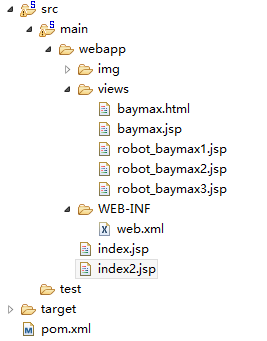SpringMVC筆記系列(2)——@RequestMapping請求對映物理檢視解析
上一篇的例子介紹瞭如何構建一個springMVC的請求對映的方法。但是@RequestMapping不僅可以修飾控制器類的方法,還可以可以修飾控制器類本身,它對請求的影響是:請求url的分段。
還是看一個例子吧。
假如現在有一個請求頁面index2.jsp。
<%@ page language="java" contentType="text/html; charset=ISO-8859-1"
pageEncoding="ISO-8859-1"%>
<!DOCTYPE html PUBLIC "-//W3C//DTD HTML 4.01 Transitional//EN" "http://www.w3.org/TR/html4/loose.dtd"> 另有3個響應頁面robot_baymax1.jsp、robot_baymax2.jsp、robot_baymax3.jsp在webapp的views資料夾下。

現在我們要做的就是用springMVC的DispatcherServlet來處理 請求頁面的請求 到 響應頁面的對映。
關於對映的詳細過程請看上一篇。
springmvc.xml配置檔案。
<?xml version="1.0" encoding="UTF-8"?>
<beans xmlns="http://www.springframework.org/schema/beans" 重點來了,我重新構造一個控制器類,來處理這種多段的請求。
定義控制器類RobotHandler。
@RequestMapping除了修飾方法,還可以來修飾類
類定義處:提供初步的請求對映資訊。相對於web應用的根目錄
方法定義處:進一步提供細分的對映資訊。相對於類定義處的URL。若類定義處沒有標註@RequestMapping,則方法處的@RequestMapping直接對應於web應用的根目錄。
這裡做個羅列,可能看得更清楚:
請求:(網站域名+web應用名)web應用根目錄+類定義處@RequestMapping+方法定義處@RequestMapping
對映到
物理檢視:webapp根目錄+springmvc.xml配置的prefix+ 控制器方法的返回值 +springmvc.xml配置的sufix
這裡的話是
請求:http://localhost:8080/mymvc/c1/m1
對映到
物理檢視webapp/views/robot_baymax1.jsp就通過控制器上的
對映過程是:DispatchServlet在截獲請求後,@RequestMapping提供額對映資訊確認請求所對應對的處理方法。
package com.happyBKs.springmvc.handlers;
import java.lang.annotation.Retention;
import org.springframework.stereotype.Controller;
import org.springframework.web.bind.annotation.RequestMapping;
/*
1.@RequestMapping除了修飾方法,還可以來修飾類
類定義處:提供初步的請求對映資訊。相對於web應用的根目錄
方法定義處:進一步提供細分的對映資訊。相對於類定義處的URL。若類定義處沒有標註@RequestMapping,則方法處的@RequestMapping直接對應於web應用的根目錄
請求:(網站域名+web應用名)web應用根目錄+類定義處@RequestMapping+方法定義處@RequestMapping
對映到
物理檢視:webapp根目錄+springmvc.xml配置的prefix+ 控制器方法的返回值 +springmvc.xml配置的sufix
這裡的話是
請求:http://localhost:8080/mymvc/c1/m1
對映到
物理檢視webapp/views/robot_baymax1.jsp就通過控制器上的
對映過程是:DispatchServlet在截獲請求後,@RequestMapping提供額對映資訊確認請求所對應對的處理方法。
*/
@RequestMapping("/c1")
@Controller
public class RobotHandler {
@RequestMapping("/m1")
String handle1()
{
return "robot_baymax1";
}
@RequestMapping("/m2")
String handle2()
{
return "robot_baymax2";
}
@RequestMapping("/m3")
String handle3()
{
return "robot_baymax3";
}
}